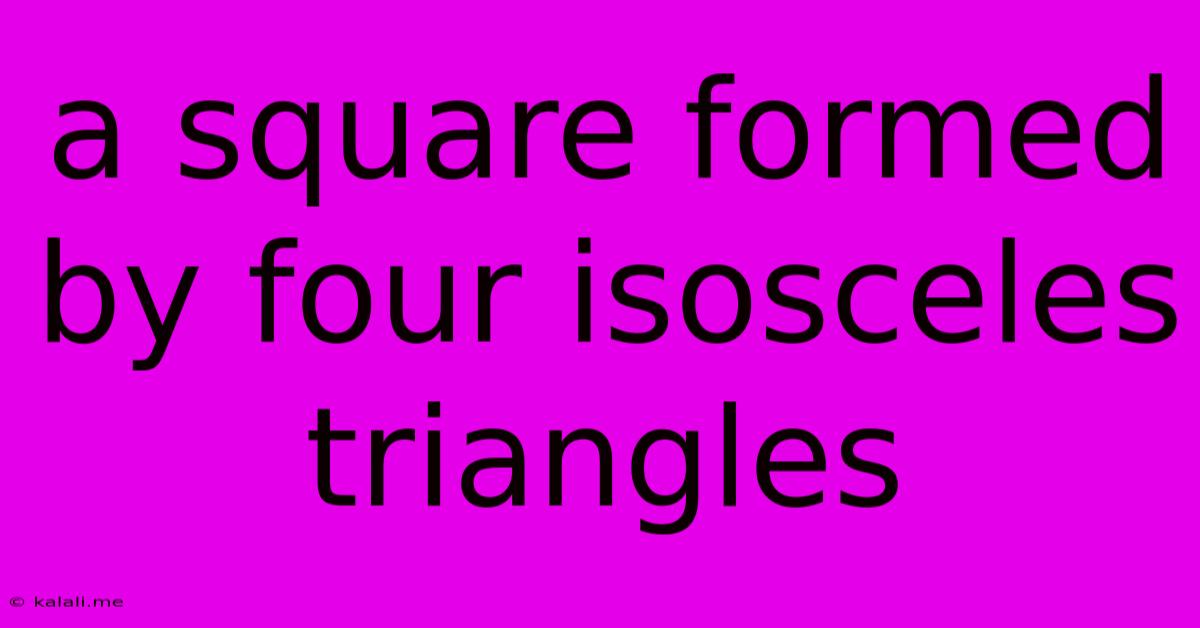A Square Formed By Four Isosceles Triangles
Kalali
May 24, 2025 · 3 min read

Table of Contents
A Square Formed by Four Isosceles Triangles: A Geometric Exploration
This article explores the fascinating geometry of a square constructed from four identical isosceles triangles. We'll delve into the properties of these triangles, the conditions required for square formation, and some interesting applications of this concept. Understanding this construction provides a strong foundation for grasping more complex geometric principles.
A square, as we know, is a quadrilateral with four equal sides and four right angles. Surprisingly, this seemingly simple shape can be elegantly constructed from a set of four identical isosceles triangles. This construction offers a visually appealing and conceptually rich exploration of geometric relationships.
Understanding the Isosceles Triangles
The key to creating a square from triangles lies in the properties of the isosceles triangles themselves. An isosceles triangle, by definition, possesses two sides of equal length (these are called the legs), and two angles of equal measure (the base angles). The third side is known as the base. Crucially, for our square construction, the base angles of our isosceles triangles must be 45 degrees.
This 45-degree base angle is not arbitrary. When four such triangles are arranged to form a square, their base angles meet at each corner of the square, creating a 90-degree angle (45° + 45° = 90°). This ensures the formation of the right angles essential to a square. The equal legs of the triangles then form the sides of the square.
Constructing the Square
Imagine four identical isosceles triangles, each with base angles of 45 degrees. To form a square:
-
Arrange the Triangles: Place the triangles such that their equal legs meet at a central point, forming a 'star' shape. Each triangle should share a leg with its adjacent triangle.
-
Joining the Vertices: The bases of the four triangles will now naturally form a square. The vertices of the triangles, where the equal legs meet, form the corners of the newly constructed square.
-
Verification: Measure the sides of the formed square; they should be equal. Further verification can be achieved by measuring the angles, which should all measure 90 degrees.
The Relationship Between Leg Length and Square Side Length
The side length of the resulting square is directly related to the leg length of the isosceles triangles. The length of each square side is equal to the length of the legs of the constituent isosceles triangles. This relationship simplifies calculations and provides a predictable outcome based on the initial triangle dimensions.
Beyond the Basics: Extensions and Applications
This simple construction serves as a foundation for more complex geometric explorations. For instance:
-
Area Calculations: Understanding this construction simplifies area calculations. The area of the square can be easily determined from the leg length of the triangles.
-
Tessellations: This construction can be used to create tessellations, where multiple squares are arranged to cover a plane without overlapping.
This exploration of constructing a square from four isosceles triangles not only demonstrates a clear geometric relationship but also provides a stepping stone to understanding more advanced concepts within geometry. The simplicity of the construction belies its significance in showcasing the elegance and interconnectedness of geometric principles.
Latest Posts
Latest Posts
-
How To Say Cute In Spanish
May 24, 2025
-
How To Say Hey In Japanese
May 24, 2025
-
How To Remove Paint Scuff From Car
May 24, 2025
-
No Hay De Que In English
May 24, 2025
-
Wii Thinks Im Using Wii Wheel
May 24, 2025
Related Post
Thank you for visiting our website which covers about A Square Formed By Four Isosceles Triangles . We hope the information provided has been useful to you. Feel free to contact us if you have any questions or need further assistance. See you next time and don't miss to bookmark.